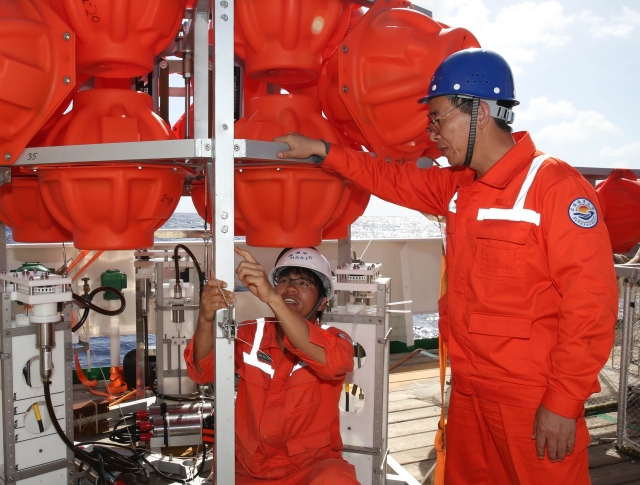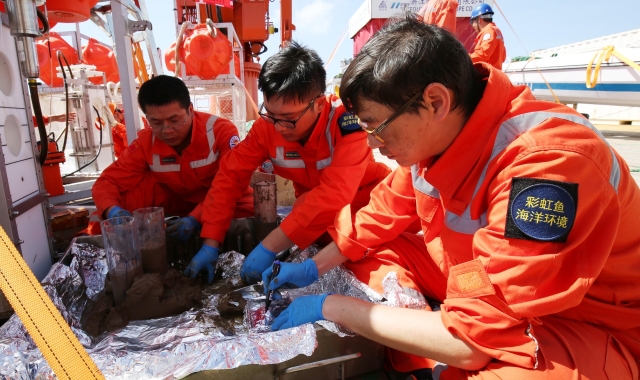On December 27, 2016, there was good news from Zhang Jian expedition ship on the Southwest Pacific where the scientific expedition organized by the Hadal Science and Technology Research Center (HAST) of Shanghai Ocean University and Shanghai Rainbow Fish Ocean Technology Co. Ltdsuccessfully launched a series of scientific investigation work by using three autonomously developed full-depth detectors (landers). This marked another substantive step for Chinese scientists to explore the unknown hadal zone.
HAST Director Prof. Cui Weicheng, leader of the hadal expedition mission, said the expedition mainly aimed at systematic scientific investigation and hadal environmental impact assessment to the hadal trenches of 6500m depth and deeperin the Southwest Pacific, lasting 3 months from December 2016 to February 2017. On December 27, the expedition team successfully launched a series of scientific work at a depth of 10000m (down to 10890m at maximum) by employing three autonomously developed 10000m-scale landers and acquired precious sample and video information of the hadal biology, microorganism and sea water. Meanwhile, these hadal tests also verified that the three autonomously developed landers made by SHOU scientists have reached design objectives and succeeded in 10000m-deep hadal test and were therefore capable of series of scientific expeditions.

No. 2 and No. 3 Landers out of Water

Cui Weicheng and Pan Binbin Discussing Mounting Details of the Load-Dump Mechanism for No. 2 Lander
Region under 6500m is defined as hadal zone by scientific community. Hadal zone is the last virgin place on earth that has not been exploited by human beings and it represents a marine ecosystem unknown to humans. The ignorance to the hadal zone will prevent human beings from making correct decisions on developing and exploiting ocean resources. Therefore, it is unprecedentedly urgent for us to explore the hadal zone and enhance our understanding to hadal ecosystem today when land resources are increasingly exhausted and large-scale development and exploitation of ocean resources is coming.
Marine hi-tech equipment is required for humans to explore the hadal zone. Full-depth lander, unmanned submersible and manned submersible are the most expected equipment for pelagic expedition by the scientists. However, due to great technical and financial challenges, such facilities are in extreme shortage in a global scale. The USA, Japan and the UK once developed full-depth unmanned submersibles and landers, but now they are rarely available. The three full-depth landers and one full-depth unmanned submersible developed by HAST indicate that China has become the third country enjoying the technology of full-depth unmanned submersibles and also the first country capable of synergic operations by unmanned submersibles and landers, making great contributions to the hadal zone research for the scientists worldwide.

Macro-organism collected from Mariana Trench Seabed by No. 3 lander

Researchers Extracting Sediment Samples Collected from Mariana Trench Seabed by No. 2 Lander
Prof. Cui Weicheng said that the operation platform backboned by Rainbow Fish manned and unmanned submersibles was the world’s first full-depth “hadal scientific and technological mobile laboratory”, which could provide a public platform for both foreign and domestic scientists to launch sustainable and systematic hadal scientific research. The full-depth “hadal scientific and technological mobile laboratory”was jointly erected by HAST and Shanghai Rainbow Fish Marine Science and Technology Co., Ltd by means of innovative modes of “national support plus civil investment” and “interaction among enterprises, universities and research institutes”. The program consists of one 5000-ton Zhang Jian scientific expedition ship, one 10000m-level full-depth human occupied vehicle (HOV), one 10000m-level full-depth autonomous remote vehicle (ARV) and three full-depth landers.

Souvenir Photo of the Expedition Team
In the future, the“hadal scientific and technological mobile laboratory” will provide a research platform for domestic and foreign scientists to explore the hadal zone and will be available for systematic scientific investigation for 26 hadal trenches below 6500m around the world to obtain marine data, deep-sea organism and micro-organism samples, establish hadal organism DNA database, promote a series of studies on hadal life sciences, explore the origin of life and make positive contributions for humans to explore the unknown deep-sea world.